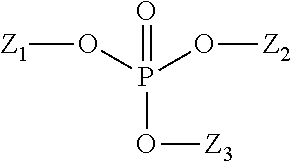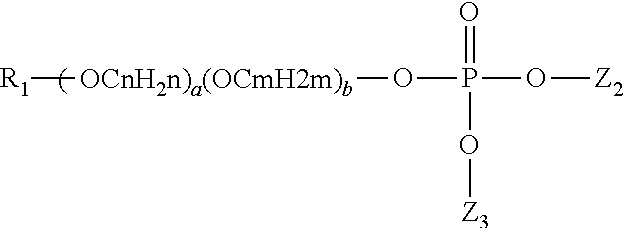Reduction in cpc taste aversion by reducing cpc activation of trpa1, tprv1, or both
a technology of cpc and receptor, which is applied in the field of cpc antagonists of trpa1 and trpv1 receptor activation, can solve the problem of lingering aftertaste of antibacterial agents, and achieve the effect of reducing cpc trpa1
- Summary
- Abstract
- Description
- Claims
- Application Information
AI Technical Summary
Benefits of technology
Problems solved by technology
Method used
Image
Examples
example 1
[0071]Assay for CPC Taste Distortion:
[0072]The assay included base taste solutions (sweet, salty, sour) and perceptual intensity evaluations by sensory panelists, as described below. The sensory panelists were 11 women all over the age of 18, and were used to generate all panel data used in the following EXAMPLES. Each panelist completed at least 120 hours of training on the definition and evaluation protocols of sensory attributes of a product / category. The training / evaluation approach is a Modified Spectrum™ method and conforms to ASTM guidelines on the Selection and Training of Sensory Panel Members. The base taste solutions (sweet, salty, sour—TABLE 1) were used to calibrate the panelists to taste intensity standards for each one of the base taste solutions (sweet, salty, sour) that they could use when evaluating the intensity of the samples and quantify the extent of CPC distortion versus taste recovery from the chemistry of invention.
[0073]Base taste solutions (sweet, salty, a...
example 2
[0082]TABLE 5 depicts the evaluation of antagonists to CPC activation of TRPA1 receptor. The activation of the TRPA1 receptor was done by combining the CPC with the TRPA1 expressing cell, in order to identify antagonists to activation of TRPA1 by CPC. HEK-293 (human embryonic kidney) cells stably transfected with human TRPA1 receptor (SEQ ID NO. 2) were grown in 15 ml growth medium [high glucose DMEM (Dulbecco's Modification of Eagle's Medium) supplemented with 10% FBS (fetal bovine serum)], 100 μg / ml Penicillin / streptomycin, 100 μg / ml G418] in a 75 Cm2 flask for 3 days at 37° C. in a mammalian cell culture incubator set at 5% CO2. Cells were detached with addition of 10 ml of PBS (phosphate buffered saline) by gentle hand shaking. Cells were transferred to a 50 ml tube and centrifuged at 850 rpm for 3 minutes to remove PBS. After centrifugation, a pellet of cells was formed in the bottom of the tube separating them from the supernatant solution. The supernatant was discarded and th...
example 3
[0088]The rinses in TABLE 7 were prepared using conventional methods known to one of ordinary skill in the art.
TABLE 7(Mouthwash Containing CPC Receptor Antagonists)ControlCPCSamplesIngredientRinse1-A1-B1-C1-D1-E1-FSuperol 5.0% 5.0% 5.0% 5.0% 5.0% 5.0% 5.0%Vegetable99.7%GlycerineUSP / FCCMaltyl—0.11%——0.05%0.05%0.05%IsobutyrateRaspberry——0.012% —0.012% 0.012% 0.012% KetoneMethyl 4-———0.012% —0.012% —PhenylButyrateDelta——————0.012% DamasconePropylene0.11%0.00%0.098% 0.098% 0.048% 0.036% 0.036% GlycolFlavor0.09%0.09%0.09%0.09%0.09%0.09%0.09%Poloxamer0.06%0.06%0.06%0.06%0.06%0.06%0.06%407Methyl0.02%0.02%0.02%0.02%0.02%0.02%0.02%ParabenPropyl0.005% 0.005% 0.005% 0.005% 0.005% 0.005% 0.005% ParabenSucralose NF0.01%0.01%0.01%0.01%0.01%0.01%0.01%Sodium0.01%0.01%0.01%0.01%0.01%0.01%0.01%SaccharinCetyl0.74%0.74%0.74%0.74%0.74%0.74%0.74%PyridiniumChlorideDye FDL&C0.0005% 0.0005% 0.0005% 0.0005% 0.0005% 0.0005% 0.0005% Blue #1Water,QS*QS*QS*QS*QS*QS*QS*Purified, USP*QS refers to the term quantum...
PUM
| Property | Measurement | Unit |
|---|---|---|
| particle size | aaaaa | aaaaa |
| particle size | aaaaa | aaaaa |
| temperature | aaaaa | aaaaa |
Abstract
Description
Claims
Application Information
 Login to View More
Login to View More - R&D
- Intellectual Property
- Life Sciences
- Materials
- Tech Scout
- Unparalleled Data Quality
- Higher Quality Content
- 60% Fewer Hallucinations
Browse by: Latest US Patents, China's latest patents, Technical Efficacy Thesaurus, Application Domain, Technology Topic, Popular Technical Reports.
© 2025 PatSnap. All rights reserved.Legal|Privacy policy|Modern Slavery Act Transparency Statement|Sitemap|About US| Contact US: help@patsnap.com


